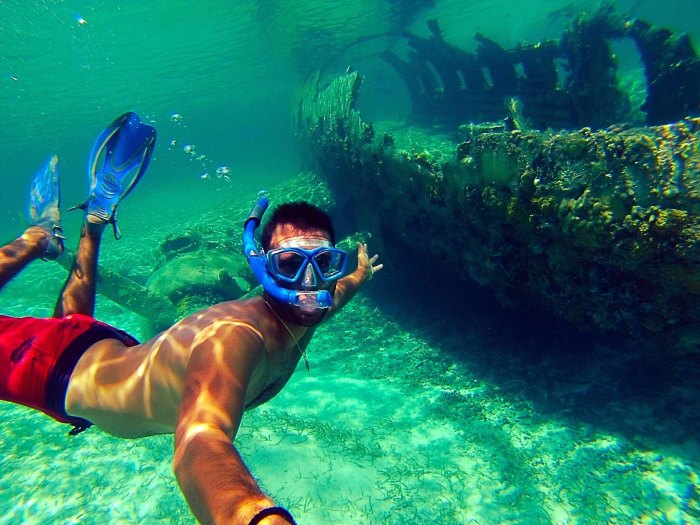Best things to do in the Bahamas: From sun-drenched beaches to vibrant underwater worlds, the Bahamas promise an unforgettable escape. Imagine turquoise waters lapping against pristine sands, the rhythmic pulse of island life, and the thrill of exploring hidden coves. This guide will unravel the best of the Bahamas, catering to every traveler, whether you crave relaxation, adventure, or a touch of history.
The Bahamas boast a stunning array of islands, each with its own unique character. Paradise Island, known for its luxury resorts, offers a glamorous escape, while Nassau provides a vibrant blend of culture and history. Exuma, with its breathtaking cays and secluded beaches, beckons adventurers and those seeking tranquil relaxation. Discover the perfect island for your next Bahamian adventure.
Introduction to the Bahamas

The Bahamas, a captivating archipelago of over 700 islands and cays, boasts a unique blend of natural beauty and vibrant culture. Known for its pristine beaches, crystal-clear waters, and laid-back atmosphere, it draws visitors seeking sun-drenched relaxation, thrilling adventures, or a luxurious escape. The islands vary significantly in size and character, offering a diverse range of experiences, from bustling city life to secluded, tranquil retreats.The archipelago’s diverse landscapes cater to various interests.
From the vibrant energy of Nassau to the secluded beaches of Exuma, the Bahamas provide an unforgettable journey for every traveler. This rich tapestry of experiences, ranging from high-end luxury to adventurous pursuits, makes the Bahamas a truly versatile destination.
Diverse Islands and Their Attractions
The Bahamas are not a monolithic destination. Each island possesses its own distinct charm and attractions. Paradise Island, with its iconic resorts and attractions, epitomizes the luxury experience. Nassau, the capital, offers a mix of historical sites, vibrant nightlife, and cultural exploration. The Exumas, renowned for their breathtaking beaches and world-class fishing, cater to those seeking tranquil seclusion and outdoor adventures.
The variety is a key draw for visitors, allowing them to customize their experience to their specific interests.
Different Types of Experiences
The Bahamas provide a wide array of experiences, catering to various preferences and budgets. Luxury resorts, with their impeccable amenities and personalized service, offer a truly pampered vacation. For those seeking adventure, the Bahamas offer exhilarating activities such as deep-sea fishing, snorkeling, diving, and sailing. For those seeking a more relaxed pace, pristine beaches, and tranquil waters provide the perfect setting for unwinding and rejuvenating.
Best Time to Visit
The best time to visit the Bahamas depends on your travel style and priorities. For those seeking the warmest temperatures and least rainfall, the months of December through April are ideal. This period also coincides with the peak tourist season, so expect higher prices and more crowds. Those seeking a more affordable and less crowded experience might consider visiting during the shoulder seasons of May through November.
The trade-off is potentially more rainfall and slightly cooler temperatures.
Comparison of Popular Islands
| Island | Highlights | Activities |
|---|---|---|
| Paradise Island | World-class resorts, casinos, and entertainment venues. | Relaxation, water sports, shopping, fine dining. |
| Nassau | Historic sites, vibrant city life, shopping, and cultural attractions. | Exploring historical landmarks, shopping, nightlife, and culinary experiences. |
| Exuma | Stunning beaches, clear waters, and world-class fishing. | Snorkeling, diving, deep-sea fishing, exploring secluded beaches, and boat tours. |
Note: This table summarizes some of the key features of each island. The Bahamas offer far more to explore than listed here.
Beaches and Water Activities
The Bahamas boasts an array of breathtaking beaches, each with its own unique charm. From powdery white sands to crystal-clear turquoise waters, these idyllic destinations offer an unparalleled escape for relaxation and adventure. Exploring the vibrant marine life and engaging in exhilarating water sports further enhance the Bahamian experience. The diversity of beaches caters to various preferences, making the Bahamas a paradise for every type of traveler.The islands’ shallow, warm waters, coupled with the abundant marine life, make them ideal for various water activities.
Whether you seek a tranquil swim or an adrenaline-fueled boat tour, the Bahamas caters to every desire. The stunning scenery, coupled with the ease of access to various water sports, makes the islands a haven for those seeking an unforgettable aquatic experience.
Renowned Beaches
The Bahamas is renowned for its pristine beaches. These beaches offer a wide spectrum of experiences, catering to different preferences and activities. From relaxing on the soft sand to engaging in exhilarating water sports, the islands provide a perfect balance between tranquility and excitement. Their unique features contribute to their appeal.
Best Water Activities
The Bahamas’ crystal-clear waters and vibrant marine life offer an unparalleled opportunity for snorkeling and diving. The coral reefs teeming with colorful fish provide a spectacular underwater world to explore. Beyond snorkeling and diving, the islands offer exhilarating opportunities for swimming, boat tours, and various other water sports.
The Bahamas are absolutely amazing, with turquoise waters and pristine beaches – perfect for relaxing. But if you’re looking for a little more excitement, checking out celebrity travel destinations like those explored by dancing stars Derek Hough on DWTS is also a great way to discover new places. For example, see what destinations Derek and other DWTS stars have visited on their celebrity travel journeys here.
Ultimately, whether you’re seeking a luxurious getaway or an adventure, the Bahamas has it all!
Places for Water Sports
Numerous locations throughout the Bahamas are ideal for various water sports. The calm waters of certain bays are perfect for leisurely swimming and paddleboarding. For those seeking more adventurous activities, areas with deeper waters and stronger currents are ideal for jet skiing and other boating activities. Each location offers a unique experience based on its specific characteristics.
Beach Comparison
The choice of beach depends largely on the traveler’s preferences. Some beaches are ideal for families with young children, offering calm waters and shallow entry points. Other beaches are more suited for couples seeking a romantic escape or thrill-seekers seeking adrenaline-pumping water sports. Understanding the unique features of each beach allows travelers to choose the perfect destination to match their specific needs and desires.
Top 5 Beaches and Their Features
| Rank | Beach Name | Water Clarity | Sand Type | Activities |
|---|---|---|---|---|
| 1 | Pink Sands Beach (Harbour Island) | Crystal clear, exceptional visibility | Unique pink sand, soft and powdery | Swimming, sunbathing, snorkeling, shallow water activities |
| 2 | Cabbage Beach (Paradise Island) | Clear, excellent visibility | Fine white sand, soft and warm | Swimming, sunbathing, snorkeling, jet skiing, parasailing |
| 3 | Gold Rock Beach (Eleuthera) | Clear, good visibility | Soft white sand, perfect for sunbathing | Swimming, sunbathing, snorkeling, diving |
| 4 | Tropic of Cancer Beach (Exuma) | Clear, excellent visibility | Fine white sand, soft and warm | Swimming, sunbathing, snorkeling, fishing, boat tours |
| 5 | Seven Mile Beach (Grand Bahama) | Clear, good visibility | Fine white sand, soft and warm | Swimming, sunbathing, snorkeling, watersports |
Culture and History
The Bahamas boast a vibrant tapestry woven from diverse cultural influences and a rich history deeply intertwined with the islands’ unique geography and the people who have called them home. From the indigenous Lucayan inhabitants to the waves of European settlers, each group has contributed to the unique identity of the Bahamian people. Exploring this history reveals a fascinating story of resilience, adaptation, and cultural exchange.The islands’ history stretches back thousands of years, beginning with the arrival of the Lucayans, who inhabited the islands before European contact.
Their legacy, though tragically diminished by colonization, continues to inspire Bahamian identity. The arrival of Europeans, particularly the British, marked a significant shift, bringing new cultures, languages, and traditions. This blending of influences is evident in the archipelago’s unique blend of traditions and customs.
Lucayan Heritage
The Lucayans, the indigenous people of the Bahamas, had a sophisticated society with a rich cultural heritage. They were skilled navigators and fishermen, with a deep connection to the sea and the land. Unfortunately, European colonization brought devastating diseases and forced displacement, significantly impacting the Lucayan population. Efforts to preserve and understand their history are ongoing, and museums and historical sites strive to share their stories.
The legacy of the Lucayans remains an important part of Bahamian identity, though limited archaeological remains exist.
Historical Significance of the Islands
The Bahamas played a crucial role in early European exploration and settlement of the Americas. Its strategic location in the Atlantic made it a significant hub for trade and transportation. The islands also witnessed significant moments in the transatlantic slave trade, and their history is marked by both opportunity and hardship.
Notable Historical Sites and Museums
Numerous sites and museums across the islands offer insights into the Bahamas’ rich past. The historical sites often provide physical remnants of past eras, from ancient settlements to colonial-era structures. These sites offer a tangible connection to the lives of past inhabitants. Museums, on the other hand, house artifacts and collections that tell the story of the islands’ history through objects, documents, and displays.
The Bahamas are a dream destination, full of stunning beaches and vibrant coral reefs. To maximize your trip, packing light is key. Consider investing in a good set of affordable luggage, like those featured in this guide on best affordable luggage sets. This will let you explore the islands with ease, without lugging around excess baggage.
From swimming with dolphins to snorkeling in crystal-clear waters, the Bahamas offer countless unforgettable experiences.
The National Art Gallery of the Bahamas is one such museum, showcasing local and international art.
Traditional Bahamian Customs and Practices
Bahamian culture is a unique blend of African, European, and indigenous influences. Traditional customs, including music, dance, and cuisine, reflect this fusion. Junkanoo, a vibrant street parade, is a significant part of Bahamian culture, featuring colorful costumes and energetic music. This celebration marks important holidays, offering a lively display of local traditions. The cuisine also demonstrates this cultural fusion, incorporating elements from various backgrounds.
Significant Historical Events
| Event | Impact | Year |
|---|---|---|
| Arrival of the Lucayans | Established the first known inhabitants of the islands, creating a unique pre-Columbian culture. | Unknown (prior to 1492) |
| Settlement by British Colonists | Marked a significant shift in the islands’ cultural and political landscape, introducing new systems of governance and economies. | 17th Century |
| Abolition of Slavery | Ended a brutal period in Bahamian history and paved the way for the development of a free labor system, leading to profound social and economic changes. | 1834 |
Food and Drink Experiences
The Bahamas boasts a vibrant culinary scene, a delightful blend of local traditions and international influences. From fresh seafood caught daily to hearty, flavorful dishes, the food in the Bahamas is a taste of the islands’ rich history and welcoming spirit. The diverse dining options cater to every palate, from casual beachside feasts to elegant fine-dining experiences. Exploring the local cuisine is an integral part of experiencing the Bahamian culture.The food scene reflects the islands’ history as a crossroads of cultures.
Spanish, African, and English traditions have all left their mark on the local dishes, creating a unique and flavorful experience. The use of fresh, local ingredients is paramount, showcasing the bounty of the sea and the fertile land.
Local Cuisine
The Bahamian diet is heavily influenced by the readily available fresh seafood. Fish, conch, lobster, and shrimp are frequently featured in various preparations, reflecting the island’s proximity to the ocean. Fruits like mangoes, papayas, and pineapples are also prevalent, adding tropical sweetness to many dishes. These ingredients are not only delicious but also contribute to the overall healthfulness of the local diet.
Dining Options
Dining options range from casual beachside restaurants perfect for a quick bite to elegant fine-dining experiences. Casual eateries offer a relaxed atmosphere and often feature local favorites at affordable prices. Fine-dining establishments provide a more sophisticated setting, with carefully crafted menus and exquisite presentations. Restaurants catering to specific dietary needs are also available, demonstrating the thoughtful approach to food in the Bahamas.
Bahamian Drinks and Cocktails
Bahamian drinks and cocktails often incorporate local fruits and spirits. The famous “Bahama Mama” is a prime example of this, blending rum, fruit juices, and a touch of grenadine. Local rum is a cornerstone of many cocktails, and the unique flavor profiles of these drinks are reflective of the tropical setting. Fresh juices and local ingredients contribute to the refreshing and flavorful cocktails.
The Bahamas are fantastic for families, offering a plethora of activities. From snorkeling vibrant coral reefs to lounging on pristine beaches, there’s something for everyone. If you’re looking for more family-friendly options in the Caribbean, check out some great destinations like the ones listed on this site dedicated to best places to visit in caribbean for families.
Ultimately, the Bahamas remain a top choice for family fun, with incredible experiences waiting around every corner.
Comparison with International Influences
The Bahamian culinary scene has been shaped by centuries of interaction with various cultures. Dishes influenced by the British, African, and Spanish traditions are present in the local cuisine, creating a diverse and fascinating experience. The fusion of international flavors and techniques enriches the Bahamian food scene.
Traditional Bahamian Dishes
| Dish | Ingredients | Preparation |
|---|---|---|
| Conch Fritters | Conch, flour, eggs, spices, onions, peppers | Conch is shredded, mixed with flour, eggs, spices, and vegetables. The mixture is formed into small patties and fried until golden brown. |
| Fish Chowder | Fish (cod, snapper, or grouper), potatoes, onions, tomatoes, milk or cream, spices | Fish is cooked with potatoes, onions, and tomatoes until tender. Milk or cream is added, and spices are blended to create a rich and flavorful soup. |
| Callaloo Soup | Callaloo leaves, fish, okra, onions, tomatoes, spices | Callaloo leaves are cooked with fish, okra, onions, and tomatoes. Spices are added for flavor. |
| Ackee and Saltfish | Ackee fruit, saltfish, onions, peppers, spices | Saltfish is cooked with ackee fruit, onions, peppers, and spices. The ackee fruit provides a unique flavor profile, and the saltfish provides a salty counterpoint. |
| Deviled Eggs | Hard-boiled eggs, mayonnaise, mustard, relish, spices | Hard-boiled eggs are peeled and mashed. Mayonnaise, mustard, relish, and spices are mixed in. The mixture is then piped back into the egg whites, or served as a spread. |
Accommodation Options

The Bahamas offers a diverse range of accommodation options to suit every traveler’s needs and budget. From luxurious beachfront resorts to cozy guesthouses and charming villas, you’ll find something perfect for your Bahamas adventure. This variety ensures that you can tailor your stay to match your preferences, whether you’re seeking a romantic getaway, a family vacation, or an independent exploration.Finding the right accommodation is crucial for a memorable experience.
Consider factors like location, amenities, and price range to make an informed decision. Understanding the different types of accommodations available will allow you to select the best option for your travel style and group.
Luxury Resorts
Luxury resorts in the Bahamas often boast exceptional amenities, including private pools, gourmet restaurants, and world-class spas. These resorts frequently feature stunning ocean views and offer a wide array of activities, catering to a discerning clientele. Many offer butler service, private chefs, and personalized experiences to elevate the overall luxury experience. Examples include the Four Seasons Resort and The Ocean Club, known for their exclusivity and high-end amenities.
Boutique Hotels
Boutique hotels provide a unique and intimate experience, often located in charming areas with local flair. These hotels frequently feature a smaller guest capacity and offer a more personalized touch than larger resorts. They may feature locally sourced artwork, unique décor, and special touches that enhance the cultural immersion of the stay. Examples include smaller hotels in Nassau or on Eleuthera.
Villas
Villas offer a more private and spacious experience. They provide ample room for families or groups of friends, allowing for more flexibility and independence. Many villas include kitchens, living areas, and outdoor spaces, perfect for hosting meals and social gatherings. They offer a sense of seclusion and homeliness, particularly beneficial for families or groups seeking independence and flexibility.
Villas range from modest to lavish and can accommodate different budgets.
Budget-Friendly Options
Budget-friendly options in the Bahamas include guesthouses, apartments, and smaller hotels. These accommodations may lack some of the high-end amenities of luxury resorts but often provide a comfortable and affordable base for exploring the islands. These accommodations are excellent for solo travelers or those seeking a more budget-conscious experience. They can be found in various locations, offering easy access to local attractions and transportation.
Comparison of Accommodation Types
| Accommodation Type | Price Range | Amenities | Best for |
|---|---|---|---|
| Luxury Resorts | High | Private pools, gourmet restaurants, spas, butlers | Couples, families seeking luxury, and those wanting all-inclusive experiences |
| Boutique Hotels | Mid-range to High | Unique décor, local flair, personalized service | Couples, solo travelers, and those seeking an intimate and culturally immersive experience |
| Villas | Mid-range to High | Kitchens, living areas, outdoor spaces, privacy | Families, groups of friends, and those wanting more independence |
| Budget-Friendly Options | Low | Basic amenities, often located near attractions | Solo travelers, backpackers, and those on a tight budget |
Activities for Families and Children
The Bahamas offers a plethora of family-friendly activities, ensuring unforgettable experiences for all ages. From pristine beaches to vibrant marine life, there’s something to captivate every member of the family. Whether you’re seeking thrilling adventures or relaxing seaside moments, the Bahamas provides a haven for creating lasting memories.Families can enjoy a wide array of activities that cater to different interests and energy levels.
From swimming and snorkeling to exploring historical sites and indulging in delicious cuisine, the Bahamas offers a diverse range of options for every family member. Planning ahead with a well-defined itinerary can help ensure a smooth and enjoyable experience.
Kid-Friendly Attractions and Activities
The Bahamas boasts a variety of kid-friendly attractions and activities that will keep the little ones entertained. These range from interactive experiences to opportunities for outdoor exploration and relaxation.
- Family-Friendly Beaches: Numerous beaches in the Bahamas are perfect for families. These often feature calm waters ideal for swimming and building sandcastles. Some beaches offer shallow areas, making them ideal for toddlers and young children. Examples include Cabbage Beach in Nassau, and the pink sands of Harbour Island.
- Aquariums and Marine Parks: Many locations offer opportunities to encounter marine life in a safe and educational setting. These can include aquariums and marine parks where families can learn about the diverse aquatic creatures found in the Bahamas. This provides a chance for children to develop an appreciation for the marine environment.
- Interactive Museums: Some museums in the Bahamas offer interactive exhibits that are designed to engage children. These exhibits often involve hands-on activities that encourage learning through play. This approach can make learning more fun and engaging for children.
- Boat Tours and Cruises: Many boat tours and cruises cater to families with children. These often include snorkeling or swimming opportunities in calm, shallow waters. They provide a fantastic way to explore the marine life and enjoy the scenic beauty of the Bahamas.
Best Places for Family Fun and Entertainment
The best places for family fun and entertainment in the Bahamas offer a variety of activities to suit diverse interests. From water sports to exploring local culture, the Bahamas provide numerous opportunities for families to create lasting memories.
- Nassau: The capital city of Nassau offers a blend of historical sites, water activities, and family-friendly attractions. The historic forts and forts, for instance, offer insights into the nation’s rich history. Water sports, such as boat tours and kayaking, are also popular choices.
- Exumas: The Exumas archipelago is renowned for its stunning beaches and calm waters. The clear waters provide excellent snorkeling and diving opportunities, while the numerous islands offer a relaxed and enjoyable atmosphere. Family-friendly activities are abundant here.
- Paradise Island: This island offers a variety of attractions, including water parks, resorts, and shopping centers. The island often features organized events and activities, such as family-oriented shows and competitions.
Kid-Friendly Attractions and Activities (Detailed List)
| Attraction/Activity | Description | Age Recommendation |
|---|---|---|
| Swimming at Cabbage Beach | Enjoy the calm waters and soft sands of Cabbage Beach. | All ages |
| Snorkeling in shallow reefs | Explore vibrant coral reefs and encounter marine life. | Children 6+ |
| Fort Fincastle tour | Discover historical landmarks and learn about the island’s past. | All ages |
| Dolphin Encounters | Interact with dolphins in a controlled and responsible environment. | Children 6+ |
| Swimming with sea turtles | Observe and interact with gentle sea turtles. | Children 8+ (with supervision) |
Luxury Experiences and Amenities
Unveiling the opulent side of the Bahamas, this section delves into the unparalleled luxury experiences and amenities available to discerning travelers. From world-class resorts to exclusive dining venues, the archipelago offers a sanctuary for those seeking unparalleled indulgence and exceptional service. Imagine pristine beaches, crystal-clear waters, and bespoke experiences tailored to your every whim.Beyond the idyllic landscapes, the Bahamas boasts a sophisticated array of luxury accommodations, gourmet dining, and curated activities that cater to the discerning traveler.
High-end resorts, renowned spas, and exclusive experiences combine to create an unforgettable vacation experience, exceeding expectations with personalized service and unforgettable moments.
High-End Resorts
The Bahamas boasts a collection of luxury resorts that redefine opulence and comfort. These havens provide lavish accommodations, exquisite amenities, and personalized service, creating an atmosphere of unparalleled relaxation and rejuvenation. Each resort is carefully designed to offer unique experiences that cater to various preferences and interests.
- The Ocean Club, Cable Beach, Paradise Island: Known for its iconic beachfront location and sophisticated ambiance, The Ocean Club offers unparalleled luxury. Its extensive amenities include a world-class spa, multiple dining options ranging from casual to fine dining, and exclusive access to private beaches and pools. The resort’s commitment to personalized service ensures each guest feels pampered and cherished.
- The Four Seasons Resort Bahamas: This stunning resort, situated on the secluded Paradise Island, provides a tranquil escape from the hustle and bustle. Guests can revel in the resort’s exclusive beach access, world-class spa treatments, and diverse culinary offerings. Exceptional service and personalized experiences make this resort a favorite among discerning travelers.
- The Rosewood Baha Mar: This beachfront resort boasts a remarkable blend of elegance and sophistication. With an emphasis on exquisite accommodations, renowned dining experiences, and bespoke activities, it provides a truly unforgettable experience. Guests can enjoy luxurious suites, rejuvenating spa treatments, and exclusive access to the resort’s private pools and beaches.
Exclusive Dining Options
From elegant fine-dining establishments to casual beachside cafes, the Bahamas offers a diverse range of dining experiences. These venues showcase the best of Bahamian cuisine, incorporating fresh, local ingredients into sophisticated dishes.
- The Ocean Club’s signature restaurant: Enjoy a world-class dining experience with exquisite cuisine and impeccable service in a luxurious setting.
- The Graycliff’s gourmet dining options: Indulge in innovative culinary creations featuring fresh seafood and local produce in a sophisticated ambiance.
- The Baha Mar’s diverse culinary scene: From casual beachfront dining to elegant fine-dining establishments, Baha Mar offers a spectrum of options to satisfy every palate.
Exceptional Amenities and Services
Beyond the accommodations and dining experiences, the Bahamas offers unique amenities and services designed to elevate the luxury experience.
- Private yacht charters: Explore the stunning coastline of the Bahamas in unparalleled style aboard a luxurious private yacht, complete with a personalized crew and exquisite amenities.
- Personalized concierge services: Many resorts offer dedicated concierge services to assist guests with planning bespoke experiences, from arranging private excursions to securing premium reservations.
- Exclusive access to private beaches and pools: Experience the serenity of the Bahamas’ pristine beaches and refreshing pools with exclusive access afforded to guests of luxury resorts.
Top 3 Luxury Resorts
| Resort | Exceptional Amenities | Services |
|---|---|---|
| The Ocean Club | Private beaches, world-class spa, fine dining options, luxurious accommodations | Personalized service, exclusive access, concierge services |
| The Four Seasons Resort Bahamas | Exclusive beach access, diverse culinary offerings, world-class spa treatments | Exceptional service, personalized experiences, private pools |
| The Rosewood Baha Mar | Luxurious suites, bespoke activities, renowned dining experiences | Exclusive access, rejuvenating spa treatments, private beaches |
Outdoor Activities and Adventures: Best Things To Do In The Bahamas
The Bahamas boasts a stunning array of natural beauty, perfect for exploring on foot, by sea, or through the air. From thrilling dives to serene hikes, there’s an adventure waiting for every visitor. The islands’ diverse landscapes, from pristine beaches to lush jungles, offer unparalleled opportunities for outdoor exploration.The vibrant coral reefs, teeming with marine life, and the dramatic coastline beckon adventurers to discover the islands’ hidden gems.
Whether you seek adrenaline-pumping activities or peaceful contemplation of nature’s wonders, the Bahamas has something for everyone.
Hiking Adventures
The Bahamas, while primarily known for its beaches, also offer surprisingly rewarding hiking experiences. While not the mountainous terrain of other destinations, the islands’ varying elevations, unique rock formations, and lush vegetation provide opportunities for exploration and breathtaking views. Trails often wind through tropical forests, past cascading waterfalls, and across diverse ecosystems. These trails offer opportunities for both casual strolls and more challenging climbs.
Kayaking and Paddleboarding
Exploring the turquoise waters of the Bahamas by kayak or paddleboard is an excellent way to immerse yourself in the island’s beauty. Kayaking tours often lead to secluded coves, hidden beaches, and vibrant coral reefs. The clear waters allow for unparalleled visibility, enabling you to observe the marine life firsthand. Paddleboarding offers a unique perspective of the coastline, allowing for a tranquil glide over the waves.
Snorkeling and Diving
The underwater world of the Bahamas is a vibrant spectacle, teeming with colorful fish, vibrant coral reefs, and a variety of marine life. Snorkeling and diving are fantastic ways to explore this hidden realm. Snorkeling provides a relatively accessible way to observe the underwater wonders, while scuba diving offers a deeper dive into the marine ecosystem. These activities often take place at well-marked locations and are led by experienced guides.
Top 5 Outdoor Adventures
- Exuma Cays Land & Sea Adventure: This multi-day excursion combines kayaking, snorkeling, and hiking in the Exuma Cays. Participants will explore the pristine beaches and coral reefs, encountering diverse marine life and enjoying the tranquility of the secluded islands. This adventure offers the chance to experience the natural beauty of the Bahamas firsthand, often including visits to local villages for cultural immersion.
- Hiking the Lucayan National Park: Experience the lush greenery and diverse wildlife of the Bahamas with a hike through the Lucayan National Park. This park is a haven for birdwatching, offering incredible views and opportunities to observe the island’s natural beauty. Participants can hike through various trails of varying difficulty, experiencing the unique flora and fauna of the area.
- Dolphin Watching and Swimming: This experience involves a boat trip to an area known for its dolphin population. Participants can observe dolphins in their natural habitat, potentially even swim with them. These tours are often conducted by licensed operators, ensuring responsible interaction with the animals. The opportunity to interact with these fascinating creatures provides a memorable and unique experience.
- Deep-Sea Fishing: Experience the thrill of deep-sea fishing in the Bahamas. The crystal-clear waters offer a chance to catch a variety of fish species, from marlin to tuna. This adventure is ideal for experienced anglers, and often includes skilled guides who can provide valuable assistance and insights.
- Island Hopping and Beach Exploration: Explore the beauty of multiple islands in a single day. This experience usually involves a boat trip that takes you to various stunning beaches and coves, allowing for relaxation, swimming, snorkeling, and exploration. The diverse landscapes of each island add to the allure of this activity, creating a day of diverse experiences.
Planning a Trip to the Bahamas
The Bahamas, a tropical paradise brimming with vibrant coral reefs, pristine beaches, and captivating culture, beckons travelers from around the globe. Planning a trip requires careful consideration of various factors, from budget and desired experiences to travel logistics and accommodations. This detailed guide will equip you with the essential knowledge to craft an unforgettable Bahamian adventure.Effective planning is key to a seamless and enjoyable trip.
It allows you to tailor your experience to your specific interests and preferences, ensuring that every moment aligns with your expectations. Careful consideration of your needs and preferences will elevate your overall trip experience.
Essential Considerations for Planning and Booking, Best things to do in the bahamas
Several factors influence the overall cost and experience of your Bahamian vacation. Understanding these aspects will help you budget appropriately and choose the perfect itinerary. Consider factors such as the time of year, desired accommodations, and planned activities when creating your budget.
- Budgeting: The Bahamas offers a range of accommodations and activities, from budget-friendly options to luxurious experiences. Careful budgeting ensures you allocate funds for all aspects of your trip, including flights, accommodation, meals, and excursions. Researching average prices for flights, accommodation, and activities will help you set a realistic budget.
- Travel Dates: The best time to visit the Bahamas depends on your preferences. Peak season (December to April) often sees higher prices and more crowds, but offers warm weather and sunny skies. Shoulder seasons (May to June and September to November) offer pleasant temperatures with fewer crowds and lower prices. Consider your priorities when choosing your travel dates.
- Desired Experiences: Do you crave relaxation on pristine beaches, exploration of underwater wonders, or immersion in Bahamian culture? Defining your interests will guide your itinerary choices. Whether you’re interested in water sports, historical sites, or cultural experiences, understanding your interests will help you plan the perfect Bahamian getaway.
Necessary Steps for Arranging Travel
Thorough planning is essential for a successful trip. This involves several key steps to ensure a smooth and stress-free journey.
- Research and Book Flights: Compare flight options and book in advance, especially during peak season, to secure the best deals and avoid last-minute price hikes. Using flight comparison websites and checking airline deals will help you find the best prices and schedule for your travel needs.
- Book Accommodations: Choose accommodations that align with your budget and preferences. Consider factors such as location, amenities, and reviews when making your selection. Reading reviews and checking photos of accommodations will help you make an informed decision.
- Obtain Necessary Visas: Determine if a visa is required based on your nationality. If needed, apply well in advance of your travel dates to avoid delays. Check visa requirements based on your citizenship to avoid any last-minute issues.
Different Ways to Explore the Bahamas
The Bahamas offers diverse ways to experience its beauty. Understanding the available options will help you tailor your trip to your interests.
- Beach Hopping: Explore the numerous stunning beaches by renting a car or using local transportation. Enjoy the sun, sand, and crystal-clear waters of various beaches. Beach hopping allows you to discover the diverse beauty and charm of the Bahamas’ coastline.
- Island Hopping: Experience the unique charm of each island by taking a ferry or boat trip. Island hopping allows you to discover the varied landscapes, cultures, and attractions of different Bahamian islands. This method allows you to experience the true beauty and diversity of the archipelago.
- Water Activities: Engage in various water sports, including snorkeling, diving, and sailing. Experience the vibrant marine life and breathtaking coral reefs. Exploring the underwater world of the Bahamas through water activities provides a unique perspective of the archipelago’s natural beauty.
Best Travel Methods and Routes
Selecting the optimal travel method depends on your destination and preferences. Consider the advantages and disadvantages of different options to plan the most efficient and enjoyable journey.
- Flights: Flights offer the quickest travel method between islands. Major international airports on islands like Nassau provide convenient connections. Flights are ideal for quick travel between the various islands of the Bahamas.
- Ferries/Boats: Ferries and boats offer a more relaxed and scenic way to travel between islands, especially for shorter distances. This method allows you to enjoy the beautiful scenery of the Bahamian waters. Ferries and boats offer a slower pace, allowing you to fully appreciate the journey.
- Renting a Car: Renting a car on some islands provides flexibility to explore at your own pace. This allows you to reach more remote beaches and locations. Renting a car on certain islands provides a high degree of flexibility and control over your itinerary.
Closure
In conclusion, the Bahamas offer a diverse tapestry of experiences, catering to a wide range of interests. From lounging on world-class beaches to exploring rich history and culture, the possibilities are endless. With a careful consideration of your interests and travel style, you can plan a trip that perfectly reflects your dream Bahamian getaway. Prepare to be captivated by the beauty, warmth, and charm of this island paradise.

























